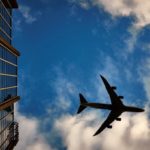The way passengers board a plane and the size of the plane could have an impact on their health, according to new, potentially far-reaching, research.
When Embry-Riddle Aeronautical University professor Sirish Namilae travels, his eyes are focused on how people are boarding the plane and moving through security and other areas of the airport.
It has become second nature for the Daytona Beach Campus assistant professor of aerospace engineering and his PhD student, Pierrot Derjany, as part of their `research that could have a worldwide impact on reducing the spread of infectious diseases in congested places such as airplanes, airports and other venues where a lot of people gather.
Boarding matters
Recently published initial findings show that the way passengers board a plane and the size of the plane could have an impact on their health. Boarding planes in three sections from the front to the back, for example, may pose more of a risk, compared to randomly boarding a plane in two sections.
With billions of passengers passing through the world’s airports each year and the numbers rising, Namilae, the lead investigator on the ongoing research, believes it’s important to find solutions.
“The research we are doing will affect people on a broad scale,” Namilae said.
A breakthrough
“Human life is priceless,” Derjany said. “I hope it will have an impact and be a breakthrough in the field.”
The concern over Ebola and plane travel hit the headlines in 2014 and 2015, with cases of people being diagnosed soon after flying commercially, putting an unknown number of people at risk.
Namilae and Derjany’s research shows changing the way people board planes could reduce the transmission of such viruses. They are also expanding their research to include analysing pedestrian density and movement in areas such as ticketing and security; boarding at the gate and baggage claim.
“We want to determine if there is anything we can do in terms of pedestrian flow that will reduce the spread of infection,” Namilae said.
Reducing the risk
The researchers are looking at various interventions such as the size of waiting areas at the gate and how they are designed.
They are using a multiscale, hybrid computer model. By applying mathematical models used in materials science such as molecular dynamics, passenger movement and boarding and deplaning was analysed around a hypothetical infected passenger, along with transmission rates and incubation periods for diseases.
The research found that the standard boarding scenario of passengers boarding a plane in three sections presented a 67% chance that more than 20 new air-travel-related infections could occur per month. The findings were based on data from the 2014 Ebola epidemic in Africa.
“Because of this pattern, the passageway is filled with passengers waiting to get to their seats, resulting in clustering,” the report states.
However, using a two-section strategy, which divides the plane into two sections and passengers randomly board, the risk is less because passengers may be in seats that are wider apart from each other which prevents clustering. The probability of 20 new air-travel related infections in this scenario drops to less than 40%.
The research found that smaller planes, like 50 seaters, would reduce the infection probability even further because of fewer passengers, a lower number of susceptible individuals within a given area and less time spent moving on the plane.
Supercomputing
“These problems have inherent uncertainty, and significant computing capability is needed to address this uncertainty,” Namilae said.
In collaboration with professor Ashok Srinivasan of Florida State University, Namilae used the Blue Waters supercomputer at the National Center for Supercomputing Applications at the University of Illinois, Urbana-Champaign, which allows accessing 100,000 processors at a time.
Namilae and Derjany are gearing up to use the new Cray supercomputer at Embry-Riddle to understand how small changes in travel policies could also impact the spread of infectious diseases on a global scale. The studies include ensuring that any changes to reduce passenger contact doesn’t disrupt travel or cause an economic impact to airlines.
“We’re trying to find the best strategy so any changes don’t effect turn time, which is the amount of time the airplane spends on the ground loading and unloading passengers and cargo,” Derjany said.

